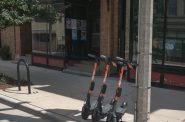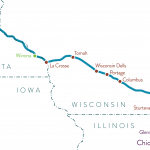“Wait, Wait, Wait”
The city’s new audio crosswalk alerts are annoying -- and potentially dangerous.
I always push the buttons at crosswalks. Being able to stop traffic rather than dodge it is a small victory for anyone burning calories instead of fossil fuel. It levels the playing field in a city that strictly regiments pedestrians.
But recently this pedestrian friendly device switched sides. Instead of stopping cars at intersections like North Avenue and Prospect or Brady Street and Farwell, a mechanical voice drones on — “wait, wait, wait.” In case I somehow overlook traffic lights, walk signs, and oncoming traffic, this audible alert system hectors me every three seconds.
Unlike a myriad of smart gadgets, this one does not adjust in real time to ambient sound. Once you push the button, it nags away even when there is no traffic. Then, when the light changes, it tell us (as though we didn’t know), “the walk signal is on, the walk signal is on, the walk signal is on.” (Just click below the image at the right to hear the message.)
If audio signals are a good idea, why not use a ring tone that only alerts you to a green light? Or if you must use words, why not just say “walk” when it’s time to do so, rather than demanding we “wait, wait, wait.”
A friend of mine was killed by a car racing through a red light. Somewhere along the line a lawyer must have pointed out a liability issue and so cities decided to add yet more protection against suits. But the audible alert system doesn’t tell you what you really need to know, that it’s safe to cross the street, that no cars are coming. That’s why dogs and humans learn to always look both ways shortly after toilet training.
This new “accessibility” feature is for the visually impaired, according to Sandy Rusch Walton, who handles PR for Milwaukee’s Department of Public Works. There are now more than 20 of these additions to our infrastructure, each costing $15,000 to $20,000. They have been installed by requests that have been forwarded by alderman to DPW. When I interviewed the two aldermen Rusch Walton mentioned, Robert Bauman and Nik Kovac, they were quick to point out these requests did not necessarily carry their recommendation, or take much thought for that matter.
Nor is it clear how much thought the city gave to these devices. It may be more about imitation: Other cities are using variations of audible alerts. They have become more or less a standard practice because they make people feel safer.
But for the visually impaired, the new devices violate the guidelines of the California Driver Handbook, which cautions, “Do not give the blind pedestrian verbal directions. A blind pedestrian listens to all traffic sounds before deciding to cross the street.” In other words, don’t blind the visually impaired. They “look” both ways too.
These new gadgets seem more like the service agreements we sign and never read on the web. Odds are we already knew not to use electronic devices (“wait, don’t use your toaster!”) in the bathtub.
According to the laws of physics humans can’t run-over automobiles. So why not start with the other side of the equation, and put these audible warnings in cars?
That’s easy, people in the information and automobile business know better. We have only so much headspace to watch where we are going. Incessant and redundant messages absorb too much of our attention and would quickly drive motorists to distraction. And before long everyone would figure out how to turn these alerts off.
Most signs are just statements of rules. “No parking” means someone can and will write you a ticket. I can’t think of instance where a sign, in the absence of strong confirmation or enforcement, changed human behavior in the right direction.
Quite the contrary, traffic research shows that people drive faster around a curve that is lit up with danger warnings than the same curve without them. We slow down the first time we come upon a “children at play” sign. But their effectiveness decays when every neighborhood group gets one. Drivers compensate by speeding up between stop signs. There’s a work around for every sign. Most drivers speed up for a yellow light that’s meant to slow you down.
Bruce Herms started this controversy with an influential 1972 paper that found, “with allowance for the number of pedestrians using the cross walks, approximately twice as many pedestrian accidents occur in marked crosswalks as in unmarked crosswalk.” His findings have since been confirmed in study after study. It sounds like a moron joke, the answer is to get rid of signs and signals.
We all know the more someone tells you what to do the less you hear them. As Hans Monderman, the legendary Dutch traffic engineer pointed out, “if you treat people like idiots, they’ll act like idiots.”
None of this is news to Jeff Polenske, the city engineer of infrastructure services for DPW, who lives on the city’s southwest side and bikes to work. He tends to agree with all the points in this article, in principle. At the same time, Polenske notes that we are going to spend millions of dollars to widen a lane in the Marquette Interchange because drivers have complained of increased traffic. Traffic engineers serve the public, the vast majority of whom are drivers, not pedestrians, and the cranky wheel gets the grease.
Polenske thinks there needs to be a cultural change in Milwaukee. No doubt, but meanwhile, ask yourself this question: what navigation system do you want drivers to be using when you cross the street? Anything that divides, diverts, or dims our attention (a cell phone, signs, or alcohol) increases a motorist’s or pedestrian’s risk.
If you are worried about the visually impaired, pass a law giving any blind or partially blind person with a guide dog or a white cane the right of way at all times and places, as is done in California. Better still, treat pedestrians as part of the transportation system and give them the right of way. Their journey is just as important as the guy in his SUV.
Pedestrians are likely to be hurt by a car driving 20 mph. At 40 mph the automobile becomes a killing machine. On the city streets, it’s common to see cars drive that fast, and all the wait, wait, waits in the world won’t provide us with any protection.
Political Contributions Tracker
Displaying political contributions between people mentioned in this story. Learn more.
- February 11, 2016 - Nik Kovac received $50 from Jeff Polenske
In Public
-
The Good Mural
 Apr 19th, 2020 by Tom Bamberger
Apr 19th, 2020 by Tom Bamberger
-
Scooters Are the Future
 Dec 19th, 2019 by Tom Bamberger
Dec 19th, 2019 by Tom Bamberger
-
Homeless Tent City Is a Democracy
 Aug 2nd, 2019 by Tom Bamberger
Aug 2nd, 2019 by Tom Bamberger


















Amen. There’s one near my house in Madison at an intersection I cross every day. I’ve given up pressing the button and just cross with the light because the voice is so damn obnoxious.
Wait a minute – the whole point of these things is to help blind people. I agree that they’re annoying, but you barely mention the reason for their existence. Also, they’re everywhere in California, especially Berkeley, 100% for the blind. I hate ’em but you ought to ask a blink person before saying they’re not helpful…
I noticed a lot of people foolishly push the buttons to get across, where they only usually work during blinking red hours. They don’t make you a car stopping demi-god.
http://www.straightdope.com/columns/read/713/do-push-to-walk-buttons-at-intersections-ever-actually-work
I do find the notices annoying, but they aren’t made for me. It would be much more interesting to hear an opinion from the visually impaired.
Dude! They aren’t for you! They are for visually-impaired people. There are Federal guidelines for these devices too. You cited a 1972 study and a driver handbook, rather than the Federally-mandated ADA engineering standards for Accessible Design, which are based on extensive research.
Here’s a website with more information on Accessible Pedestrian Signals, as well as some more up-to-date research on their effectiveness: http://www.apsguide.org/
“for the visually impaired, the new devices violate the guidelines of the California Driver Handbook, which cautions, “Do not give the blind pedestrian verbal directions. A blind pedestrian listens to all traffic sounds before deciding to cross the street.” In other words, don’t blind the visually impaired. They “look” both ways too.”
I know they are not for me but it is an open question whether they are good for blind people. The audio alerts greatly diminish a blind persons ability to sense the world. Given that so many of our pedestrian deaths occur because of inattentive drivers who go through lights it may be better not to do anything that might further impair their sense of danger when crossing a street.
And again, if we are concerned about the safety of visually impaired pedestrians, why not put the burden on the motorists? Why not give blind people the right of way!
We got smart phones and cars, don’t you think our signage could be a little smarter as well. It’s worth noting that the intersections on east side where the audio alerts are have not had a pedestrian death in more than 10 years, if ever in recent memory.
In London, all of the crosswalk signals that I noticed only had a clicking noise that alerted the visually impaired, with no annoying audio. The clicking seemed loud enough to serve its purpose, but not so loud that it was obnoxious. There has to be a happy medium that is effective for those who need it and not so annoying to the rest of us, like what we have now. Like what others have said though, it’s hard for us to make the call without consulting the visually impaired first.
@tom Jogger was hit about 6 years ago at that intersection:
http://www.jsonline.com/news/milwaukee/29424369.html
How did the editor let this one through? Everyone out for the 4th and the keys were left with the high school intern? It is for visually impaired.
Next up for this week, Michael Horne hiding in the bushes and taking photos of people who are waiting at this crosswalk, Dave Schlabowske standing on the corner and yelling and cars that have to slam on the breaks when cyclists blow through stop lights, and Bruce Murphy blaming the weather on the Milwaukee County Board even though Chris Abele is standing next to him with Cobra’s Weather Dominator.
Indianapolis has something similar to these, but, like Peter mentioned, only make a someone calming chirping noise while you can walk, speeding up slightly as the time is lapsing. Much better than some robo-voice. Regardless, its a needed feature for our seeing-impaired.
To all of you who berate Tom that these are for the visually impaired (Tyrell, Begonia and John), are your attention spans so low that you couldn’t read his entire article and just got so frustrated you HAD to comment after only reading a few sentences? HE CLEARLY STATES that these were intended for the visually impaired, but that they ironically make traffic less-audible and therefore crosswalks less safe by drowning out the other sounds of the street and only telling the pedestrian that “the walk sign is on” and not that the crosswalk is actually safe (I think Tom’s point is that for $15,000 a pop, why are they such simplistic technology? Couldn’t they have motion sensors that would verbally alert visually impaired and others that a fast moving vehicle may be coming toward the intersection??)
I think the point of Tom’s article, too, is that we need to stop blaming the victims, i.e.. pedestrians and bicyclists and YES, pedestrians and bicyclists are ALWAYS the victims because the cars and trucks on the road weigh 5,000lbs and travel at high speeds while people on foot and on bike aren’t going to kill anyone by bumping into them.
The responsibility of keeping the streets safe to pedestrians should lay heavily on the shoulders of the motorists… especially in downtown urban areas, where our streets are primarily for the people. American drivers are far too aggressive and ignorant to the existing laws… even the police go through marked crosswalks when pedestrians are trying to cross!! There is a state law that says all motorists MUST YIELD to pedestrians in crosswalks… Translation: If you approach a crosswalk in a car and you see someone with even just ONE TOE in the crosswalk, you MUST STOP and let them cross, even if they are on the opposite side of the street as you. Anything less is breaking state law, and yet most of the numbskulls in this state don’t ever do that. It will require a deep cultural change (maybe one with jail time for violators) to change this lazy attitude of Wisconsin drivers, but it must be done.
I live more than a half block away from the Prospect/Brady intersection, up three floors in a very thick-walled apartment building. I can hear Mr. Wait, Wait, Wait inside my apartment. Plus, the beeping sounds that indicate it’s no longer okay to walk have been on constantly once the traffic control lights in both directions turn to flashing (at midnight?). I can’t speak for any visually impaired people in the neighborhood, but I would think these blaring sounds, whether voices or beeping, would, indeed, be distracting to their ability to sense their surroundings.
Also, if they’re JUST for the visually impaired, why do they have signs that say “push button for walk signal” written above them…in words….that you need your eyes to read…?
Poor me, I have one Mr. Wait Wait outside my office window on Prospect & North and another near my 8th floor apartment a block from Brady & Farwell, and while I would never do it, I can imagine a terrific feeling of justification at taking a #38 baseball bat to them in the night. Open my office window on a nice day? Out of the question. Sleep with the windows open? Not without a little white noise, the ceiling fan, perhaps, to mask Mr. Wait Wait. I sleep fine when the bus pulls up outside the building and beeps when kneeling, but Mr. Wait Wait wakes me up. Oh, and I am a city-dweller who opts not to own a car, I walk everywhere, but I did fine without Mr. Wait Wait and, as Tom has already spelled out, blind people (anybody ever actually see any blind people on the East Side?) don’t use or appreciate them, either. Somebody at the City was sold a bill of goods.
Did anyone find out that the ONLY thing those damn buttons do is activate the instructions for the visually impaired. They do not change the timing between the light changes. Do not use the buttons unless you them to negotiate the intersection. Now if you want something that’s really annoying how about we outlaw car alarms, back up signals on trucks and bells that keep ringing when the river bridges are raised.
Yea Jeff! Is a honking car horn really necessary to tell you that your doors are locked? Does anyone really believe a car is being broken into when a car alarm goes off? I once shouted, “Back away from the car,” to some people who set off a car alarm. The perps said, it’s our car! I said, that’s what they all say. Remember, it’s the job of automobile manufacturers and highway builders to create more demand for their products. Once they drive you out of the city with their worthless noisemakers and their right turn by-pass lanes, you’ll have to drive!
@keith I have actually seen a fair amount of blind pedestrians crossing at the Brady/Farwell intersection. Again, I think the things are annoying, but until there is a response from the visually impaired… its just complaining about an annoyance.
Well, I’m not going to hold my breath for the visually impaired to jump into an online comment section. Have a safe 4th, and listen both ways when crossing the street.
@jeff- you’re close. Pressing the button turns on Mr Wait Wait, but at Farwell & Brady, you won’t Mr White Guy to cross Brady UNLESS you press the button, blind or not! I don’t care, I’m a grown man, I cross when it’s safe, I gow with the green, whether White Guy is on the job or not. Mr White Guy is for kids and old people, but I see folks every day, with a green on Farwell or Cambridge, stand and wait for Mr. White Guy, but they didn’t press the damned button, so they didn’t get him.
https://nfb.org/Images/nfb/Publications/bm/bm03/bm0301/bm030102.htm
http://acb.org/node/617
See above for some perspectives about the Accessible Pedestrian Signals (APS)
direct from the National Federation for the Blind and American Council of the Blind.
Their main points :
1) Don’t put them up everywhere, just selected intersections where they would be helpful,
2) Ticks are, generally, better than speech, and
2) Not too loud, please.
Frankly, I kind of like the rhythm of the “Wait…wait…wait” ; I find myself busting a dance move to the beat. I think we should have mimes stationed at the corners instead, or maybe just Therapy dogs.
Hello, I know this original post is extreme old. But I live in an area where an abundance of our community is Visually Impaired aka “blind”. These are very hard working folks with great FullTime jobs and they obviously need to take public transportation to get to work daily. When you travel on bus,trolley, train , etc with that comes ALOT of walking! I’m super grateful for these audio alerts and now with so many people talking on there cell phones and young kids as well playing games and not paying attention ; I can only imagine how many lives have been saved!
Thanks For Your Time!!